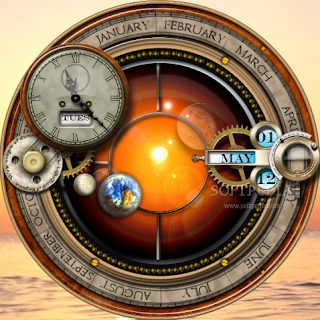21 June is the longest day and 3 Jul is the shortest.
Many people consider the first day of summer to be the longest day of the year (if you count just the daylight time). But did you know that 3 July can be considered the shortest day of the year (and this year it is the 54rd anniversary of WWVB)?
How long is a day?
Ask someone how long a day is and you will probably get the answer, "24 hours". However, ask someone at the US Naval Observatory (and at WWVB) and you will get "9,192,631,770x60x60x24 cycles of the standard cesium-133 transition". Ask a farmer and you will get "From sunup to sunset". We have any different definitions. For this post, I am going to use the synodic definition, the time it takes the Sun to go from due south (local solar noon) to the next time it is due south for an Earthbound observer.
It starts with Kepler.
Thanks to Johannes Kepler, we know that the Earth orbits the Sun in an eliptical orbit, and that the Earth is moving fastest when it is closest to the Sun (perihelion) and slowest when it when it is farthest (aphelion).
This year, aphelion occurs on 4 Jul at 12:24 EDT, which will be the shortest day of the year.
Let's figure it out.
Since on the above diagram, the Earth is also spinning counter-clockwise, the diagram below shows (with the added lines) one complete rotation of the Earth for both the day of aphelion (3-4) and the day of perihelion (1-2).
Notice that it takes a little more than one rotation of the Earth to have the Sun directly due south again. Also notice that the Earth has to rotate a little more at perihelion than at aphelion to be facing the Sun 1 synodic day later. So a synodic day is shortest at aphelion.
But how much shorter is it?
While the above argument is enough to show that 4 Jul 2016 is the shortest (synodic) day of the year, it does not say by how much. Is it minutes or milliseconds? To answer this, we will need some numbers and the more precise form of Kepler's Law used above. Kepler figured out that orbiting bodies sweep out equal areas in equal time. And by looking at the diagram above, you can see that the angle swept out by the Earth in one sidereal day is equal to the extra angle the Earth has to rotate to get the Sun due south for an Earthbound observer.
Since the area of a circular sector is
this gives the relationship between for angles swept in equal time.
The Earth-Sun distance is 152,098,232 kilometres (or 1.01671388 AU) at aphelion and is 147,098,290 kilometres (or 0.98329134 AU). This gives
Microseconds or Hours?
So, the Earth rotates around the Sun just a little bit less on 6 July than on 4 January. Since the Earth rotates about 1 degree (actually 360/364 degrees), it rotates about 0.033 degrees less on 5 July for 1 synodic day than on 4 January. How long does it take the Earth to rotate that angle? Since it takes 24 hours to rotate 360 degrees, it takes about 8 seconds to rotate that 0.033 degrees. So the synodic day on 6 July is about 8 seconds shorter than the synodic day on 4 January.
Classroom use.
Unless you are teaching summer school, this is not much use in the classroom. However, if you flip the seasons, you can show that the day of perihelion is the longest day of the year (and it is close the the "shortest" day of the year, 22 Dec). Since the first day back from the Christmas break is close to 4-5 Jan, I use this for a gradual welcome-back class. In a regular physics class, we just do the qualitative approach with students playing the parts of the Sun and the Earth.
The discussion starts with what causes the seasons. It helps to have a globe handy at this point. We then discuss Kepler's laws. I get one student to play the part of the Sun and one the Earth. Depending on time, I might have the class discuss how the Earth should rotate (the Sun rises in the east). If not, I will just get the Earth rotating in the correct way. The class decides when the Earth has rotated one complete rotation relative to the room and then notices that it is the Earth (the student) is not facing the Sun. That 5 minute activity sets up the above discussion.
A related post (http://canisiusphysics.blogspot.com/2013/03/if-spring-starts-tuesday-why-does.html)






.gif)
.gif)